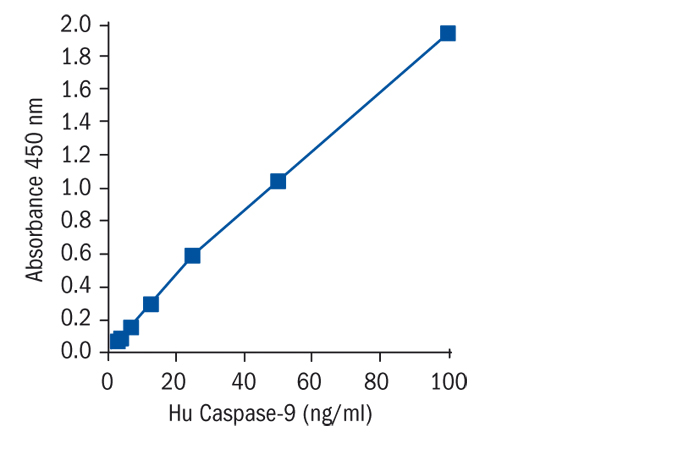Type
Sandwich ELISA, 2nd HRPlabelled antibody
Applications
Serum, Cell culture supernatant, Cell culture lysate
Sample Requirements
50 µl/well
Shipping
At ambient temperature. Upon receipt, store the product at the temperature recommended below.
Storage/Expiration
Store the complete kit at 2–8°C. Under these conditions, the kit is stable until the expiration date (see label on the box).
Calibration Curve
Calibration Range
1.6–100 ng/ml
Limit of Detection
0.4 ng/ml
Intra-assay (Within-Run)
CV = 6.6%
Inter-assay (Run-to-Run)
CV = 9.0%
Spiking Recovery
102,70%
Dilution Linearity
102,80%
Research topic
Apoptosis, Immune Response, Infection and Inflammation
Summary
Caspases are the executioners of apoptosis. This cysteine protease family consists of more than 10 related members characterized by almost absolute specificity for aspartic acid in the P1 position. Caspases are synthesized as inactive proenzymes comprising an N-terminal peptide together with one large and one small subunit. Activation of caspases during apoptosis results in the cleavage of critical cellular substrates so precipitating the dramatic morphological changes of apoptosis.
Caspase-9, formerly called Apaf-3, binds to Apaf-1 in the presence of cytochrome c and dATP, which leads to caspase-9 activation. Activated caspase-9 in turn cleaves and activates caspase-3; caspase-9 thus is the most upstream member of the apoptotic protease cascade that is triggered by cytochrome c and dATP.
Caspase-9 is essentially localized in mitochondria, the disruption of the outer mitochondrial membrane occurring early during apoptosis is critical for its subcellular redistribution and activation.
Apart from cleavage of caspase-3, the downstream enzymes caspase-6 and –7 are targets of caspase-9 activity . Caspase-9 forms dimers in the course of activation. Cytochrome c/Apaf-1/caspase-9 form a socalled apoptosome, amplifying the caspase cascade. Feedback cleavage of caspase-9 by caspase-3 again significantly increases the activity of the apoptosome .
Caspase-9 plays a crucial role in all pathologies involving apoptotic processes. Specifically the involvement of caspase-9 has been described in human gastric cancer ovarian carcinoma, neuroblastoma, gliomas as well as in Alzheimer´s disease, Huntington´s disease and osteoarthritis .
Find documents for the lot
Example Instructions for Use (RUO)
Example Instructions for Use (RUO)
Safety Information (RUO)
MSDS (RUO)

